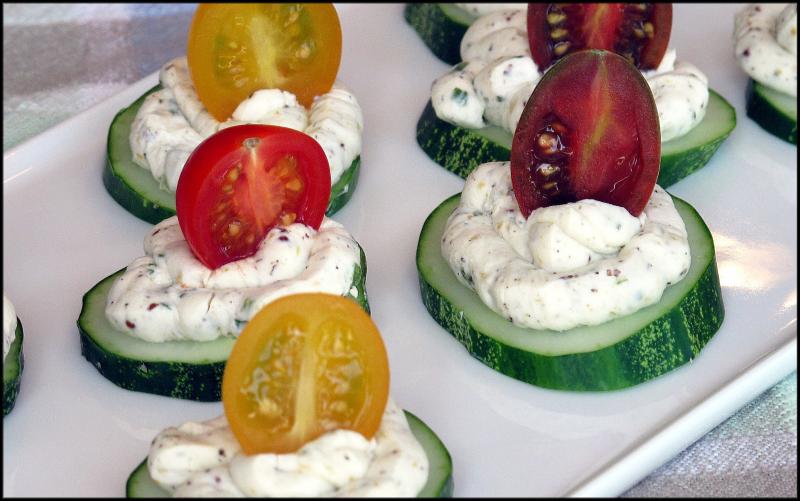Cucumbers offer variety of bright summer tastes
Because our yard backs up to Cape Henlopen State Park, we are frequently visited by deer, fox, rabbits, squirrels and birds of every stripe. While we enjoy watching the wildlife, it’s not possible to plant a vegetable garden with that much nearby traffic. This year, I tried planting in pots outside on the second-floor porch and so far, so good.
The selection at Garden Shack Farm in Milton included choices that would work well in pots, so I collected peppers, cucumbers, eggplant and melon, all of which are now thriving nicely. And, some of the cucumbers were already big enough to harvest, which gave me the freshest ingredients for this week’s recipes.
With a history that spans over 4,000 years, cucumbers are a member of the gourd family, Cucurbitaceae. Considered vining crop plants, cucumbers are related to over 800 different plants, including the numerous varieties of watermelon, cantaloupe and squash, all of which share a slightly bumpy exterior, sweet flesh and centrally located seeds.
Cucumbers originated in ancient India, where they grew wild until brought under domestication, and ultimately the crop was traded to countries across the Middle East and Europe. As with many foods, the Roman Empire was largely responsible for the cucumber’s growth in popularity, both as a food and a medicinal remedy. In the 15th century, Columbus brought cucumbers to the New World, where they have flourished ever since.
In current usage, cucumbers fall into three types: slicing, pickling and burpless. The first two are fairly simple to appreciate – slice them into salads, or pickle them in a sweet or sour (or both) brine. What makes a cucumber bitter is a naturally occurring compound called cucurbitacin. This is a defense mechanism for the plant, making it unpleasant for animals to forage, and it is also the reason many people burp after eating cucumber.
The burpless varieties were bred to reduce the amount of this compound, making them more palatable (and more socially acceptable). If your cucumbers are not one of the reduced-cucurbitacin variety, you can actually remove most of it by “milking” the cucumber. Simply cut off one end of the cucumber and rub in it in a circular motion, cut edge to cut edge. You will see a foamy white substance begin to leak out; this is the bitter compound that is primarily stored in the skin.
Another secret to better-tasting cucumbers is how you store them. Once they’re harvested, they should be kept at room temperature and consumed within a few days. If you place them in the refrigerator (or chill them like grocery stores do) they will incur cold injury, causing the flesh to decay as they become watery and pitted.
Now that you have your fresh, tasty cucumbers, what will you do with them? One option is the array of canapés in the photo. Here, cucumber slices are topped with herb-flavored cream cheese and a cherry tomato half. While they are attractive with the tomato standing, I recommend laying it flat before taking a bite. You can either use Boursin cheese or make your own version from minced fresh herbs and cream cheese.
There is a wide range of recipes for cucumber salads, coated with either a creamy dressing or sharp vinaigrette. I’ve included a recipe for each type. Dill and cucumber are flavors that work well together, especially in this delicate cucumber soup.
Creamy Cucumber Salad
1/2 C sour cream
2 T mayonnaise
1 T white vinegar
1 T snipped dill leaves
1 t sugar
1/2 t salt
1/4 t garlic powder
3/4 C thinly sliced red onion
3 C peeled, thinly sliced cucumber
Combine sour cream, mayonnaise, vinegar, dill, sugar, salt and garlic powder in a serving bowl. Whisk to combine. Stir in red onion and cucumber. Cover with plastic wrap and chill in the refrigerator for at least 2 hours.
Cucumber Vinaigrette Salad
1/3 C seasoned rice wine vinegar
3 T olive oil
2 T snipped dill
2 sliced green onions
2 C thinly sliced cucumbers
salt & pepper, to taste
Whisk together vinegar, oil, dill and green onions. Add cucumber and toss to coat. Adjust seasonings with salt and pepper. Cover with plastic wrap and refrigerate for at least 2 hours before serving.
Cucumber Soup
1 lb cucumbers, peeled and chopped
1/2 C plain yogurt
3 T lemon juice
2 T olive oil
1 T chopped dill
salt, to taste
lemon zest, for garnish
Combine cucumbers, yogurt and lemon juice in the bowl of a blender or food processor. Pulse while gradually adding the olive oil, processing until incorporated. Transfer to a serving bowl and stir in dill; season to taste with salt and pepper. Serve at room temperature or chilled, garnished with lemon zest. Yield: 4 servings.
SIDEBAR
You never know who might be reading the Cape Gazette. After last Friday’s column about pizza, I received an email from the folks at the Wewalka Pizza Crust company. They expressed their disappointment that my experience wasn’t the best and included a few tips on how better to cook their crusts (pre-baking after brushing with a very light coat of olive oil) and suggested other ideas on their website, www.wewalka.us. When they offered a coupon for me to try a replacement crust, I told them that wasn’t necessary, but I appreciated the quality of their customer service.














































